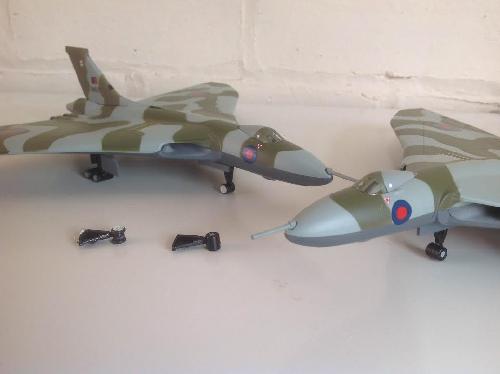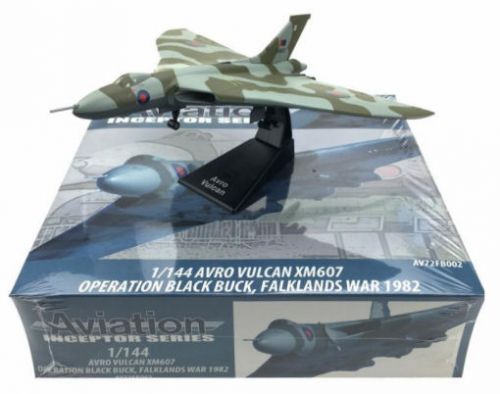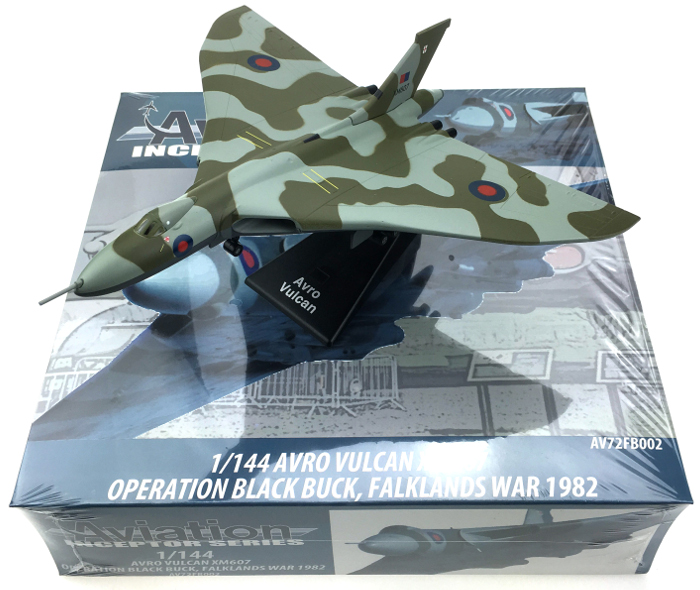Avro Vulcan B2 – XM607, Black Buck, Falklands War, Preserved (With Corgi Undercarriage) 1/144
Add to compare2 in stock
£19.99
2 in stock
Aviation Inceptor 1/144th scale AV72FB002: Avro Vulcan B2 XM607, Operation Black Buck, Falklands War 1982. A correctly coloured, reasonably detailed model with fixed lowered undercarriage and stand at a budget price.
Length 8.25 inchesWingspan 9.25 inches
PLEASE NOTE: The nosewheel had been incorrectly fitted by the factory on these models. It was located at the rear of the nose undercarriage bay rather than the front. Also the leg and wheel assembly was a rather crude and simple looking affair. I have replaced the nose leg and wheel assembly with a Corgi one, which has the correct twin split wheels rather than the horrible old one. Also this is now correctly fitted at the front of the nose bay well. I have attempted to show this on the photo. The revised one is on the left. The old and new parts are in the foreground. Only one model is included.
XM607 managed to put the Port Stanley runway out of action with a 1,000 pound bomb, thereby preventing its use by Argentine planes. This superb aircraft can now be seen preserved opposite the RAF Waddington Aircraft Viewing Enclosure (WAVE).
Avro Vulcan XM607, the 71st production B.2 was delivered to the RAF on the 31st December 1963 and was allocated to 35 Sqn. at RAF Coningsby on the 1st January 1964. On the 30th March 1965 while still with 35 Sqn. she was moved to Cottesmore and then to RAF Waddington on April 25th 1968. The 27th March 1975 saw 607 transferred to No. 44 (Rhodesia) Sqn. but remaining at Waddington. In April of 1979 saw a move to 9 Sqn. and then briefly to 101 Sqn. before returning back to 44 Sqn. on December 17th 1980, where she served out the remainder of her service life. With the Vulcan due to be retired entirely in June 1982, only 3 Sqns. remained operational when, in early April that year, the prospect of war with Argentina seemed unavoidable. Ten Vulcans were ordered to have their air to air refuelling capabilities restored and of these 5 were selected to be converted to full conventional bombing standard; XM607 being one of them.
With all Sqn. markings removed and the underside’s painted in dark sea Grey, XM607 along with XM598 left RAF Waddington for Ascension Island on the 29th April 1982. The first mission named Black Buck 1 was to leave just before midnight on 30th April with 607 as the reserve aircraft. After 598 became unserviceable due to a faulty window seal, 607 captained by Ft. Lt. Martin Withers went on to become the first Vulcan Bomber to be used in anger, successfully bombing the runway at Port Stanley in the Falkland Islands and entered the record books for the longest bombing mission in the history of the RAF. XM607 went on to perform two more sorties in the conflict, Black Buck 2 & 7; the latter being the final Vulcan mission.
On the 17th December 1982, 607 was retired from service and on the 21st December as the star of the ceremony in Hangar 2 at RAF Waddington she oversaw the disbandment of No. 44(Rhodesia) Sqn. January 18th 1983 saw her allocated to static display, and after many moves around Waddington she now stands as guardian alongside the A15 and opposite the WAVE on the A15. With structural surveys having being carried out on the 28-29th August 2013 to assess her condition she was found to be in relatively good order and will be restored and remain as Waddingtons guardian for many more years to come.
The Avro Vulcan, sometimes referred to as the Hawker Siddeley Vulcan, was a jet-powered delta wing strategic bomber, operated by the Royal Air Force (RAF) from 1956 until 1984. Aircraft manufacturer A V Roe & Co (Avro) designed the Vulcan in response to Specification B.35/46. Of the three V bombers produced, the Vulcan was considered the riskiest option. Several scale aircraft, designated Avro 707, were produced to test and refine the delta wing design principles.
The Vulcan B.1 was first delivered to the RAF in 1956; deliveries of the improved Vulcan B.2 started in 1960. The B.2 featured more powerful engines, a larger wing, an improved electrical system and electronic countermeasures (ECM); many were modified to accept the Blue Steel missile. As a part of the V-force, the Vulcan was the backbone of the United Kingdom’s airborne nuclear deterrent during much of the Cold War. Although the Vulcan was typically armed with nuclear weapons, it was capable of conventional bombing missions, a capability which was used in Operation Black Buck during the Falklands War, a conflict between Britain and Argentina in 1982.
The Vulcan lacked defensive weaponry, initially relying upon high-speed high-altitude flight to evade interception. Electronic countermeasures were employed by the B.1 (designated B.1A) and B.2 from circa 1960. A change to low-level tactics was made in the mid-1960s. In the mid 1970s, nine Vulcans were adapted for maritime radar reconnaissance operations, redesignated as B.2 (MRR). In the final years of service, six Vulcans were converted to the K.2 tanker configuration for aerial refuelling. Since retirement by the RAF one example, B.2 XH558, was restored for use in display flights and air shows, but ceased flying in October 2015.
| Weight | 1.2 kg |
|---|



